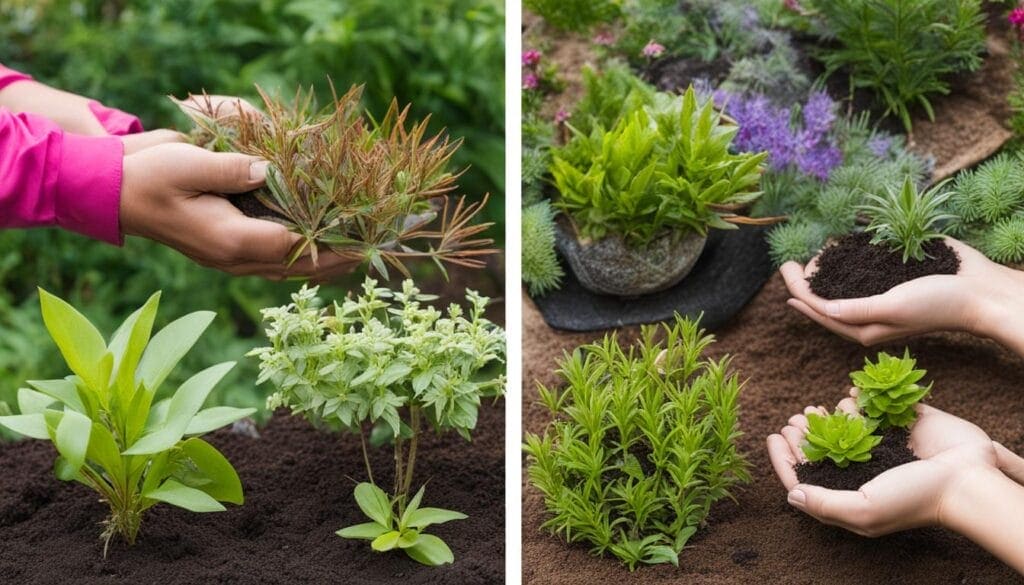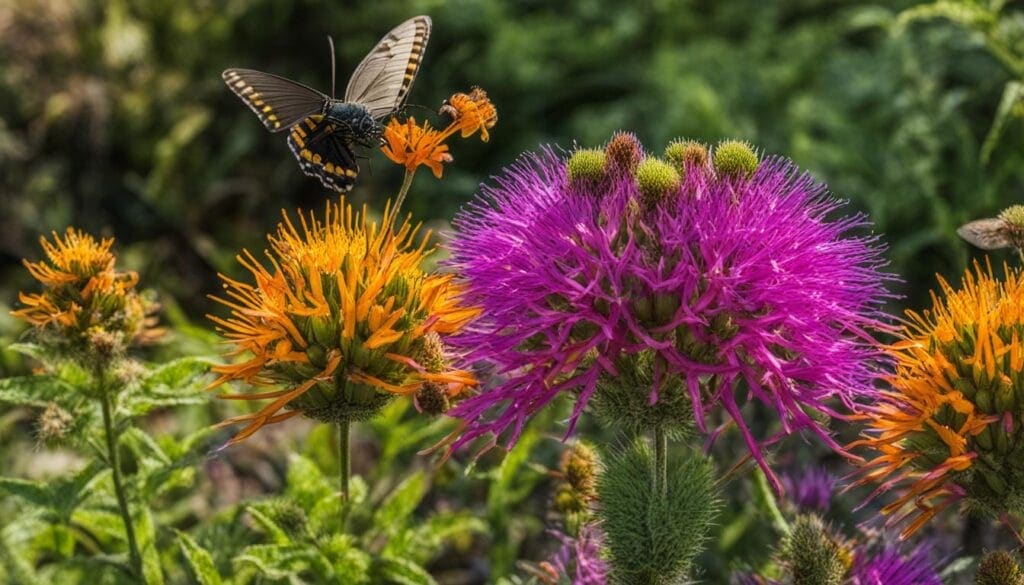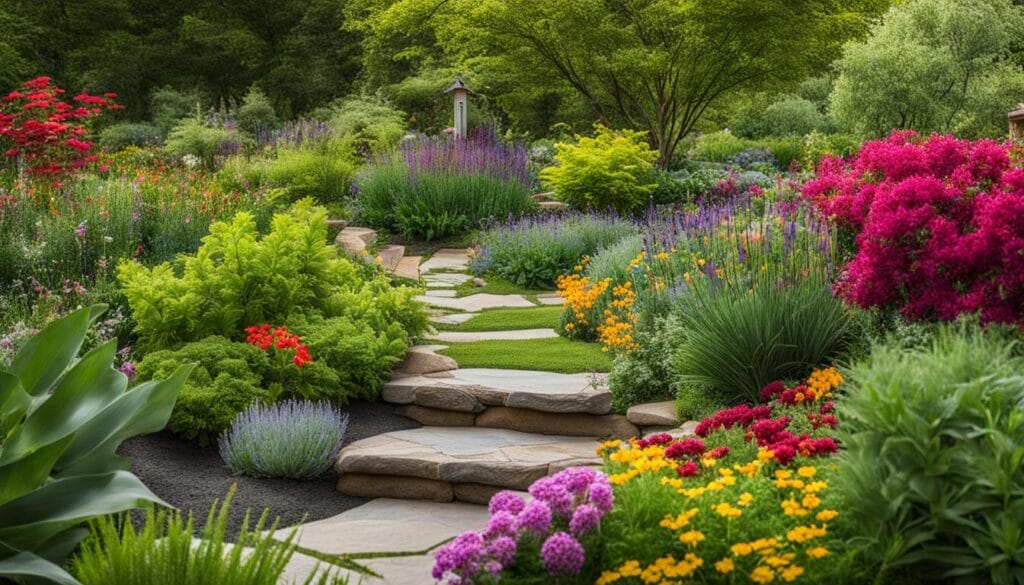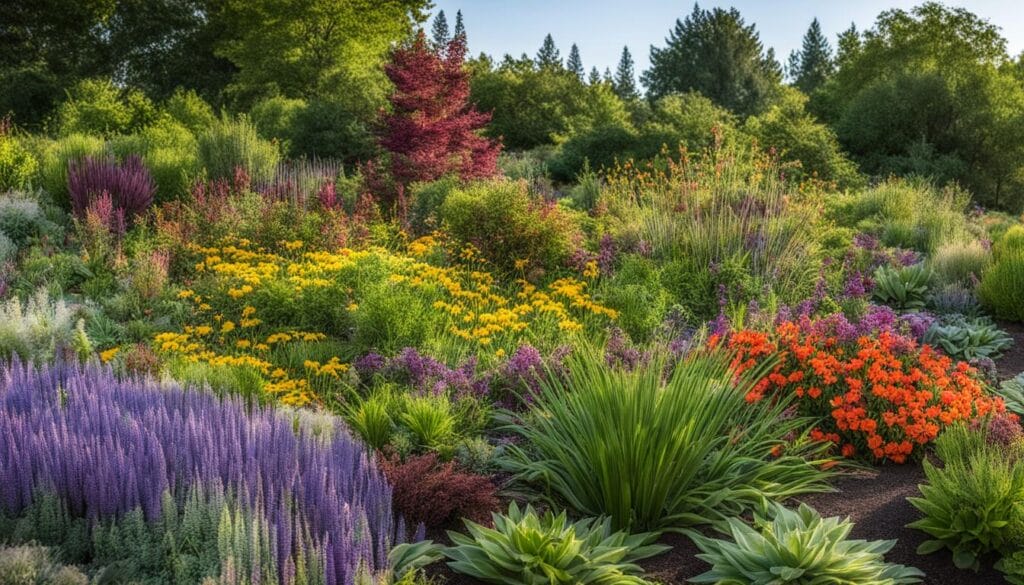Welcome to our guide on the benefits of native plants in eco-friendly landscaping. If you’re looking to make your outdoor space more sustainable and environmentally friendly, incorporating native plants is a fantastic choice. Not only do they bring beauty and diversity to your landscape, but they also provide numerous advantages for both the ecosystem and your gardening efforts.
Key Takeaways:
- Native plants attract indigenous fauna and create self-sustaining ecosystems, boosting biodiversity.
- They are environmentally resilient, adapted to local climate conditions, reducing water usage and maintenance.
- Victoria, Australia sets an example by integrating native plant requirements into development projects and public spaces.
- Using native plants in landscaping promotes sustainability, reduces maintenance, and supports wildlife.
- By embracing native plants, you can contribute to a more eco-friendly future.
Victoria’s Unique Flora and Fauna: A Tapestry of Biodiversity
Victoria, Australia is home to a rich assortment of native plant species, contributing to its remarkable biodiversity. From the coastal regions to the mountainous areas and wetlands, each unique habitat supports a diverse array of flora and fauna. These native plants play a vital role in maintaining the delicate balance of ecosystems and provide numerous advantages for sustainable gardening.
In coastal areas, native plants have evolved to thrive in salt-laden winds and sandy soils. Species such as Saltbush and Pigface are well-adapted to these challenging conditions, serving as resilient options for coastal landscaping. Meanwhile, the mountain regions boast unique alpine species like Snow Gum and Mountain Pepper, adding character and beauty to the landscape.
“The diversity of native plants in Victoria creates a vibrant tapestry of colors, textures, and scents, attracting a wide variety of native wildlife,” says Dr. Emily Watson, a leading botanist in Victoria.
Wetlands and waterways are crucial ecosystems that are prioritized for preservation in Victoria. These habitats are home to an abundance of native aquatic plants, including species such as Water Ribbons and River Red Gum. Preserving wetlands not only protects these valuable plant species but also supports the biodiversity of the surrounding areas.
Furthermore, the strategic planting of native trees in urban forests helps combat climate change and improve air quality. Species like River Red Gum and Blackwood provide shade, act as carbon sinks, and create a habitat for urban wildlife. These green spaces enhance the livability of cities while contributing to the overall health of the environment.

The Benefits of Victoria’s Unique Flora and Fauna:
| Advantages | Native Plants in Victoria |
|---|---|
| Enhanced Biodiversity | Coastal: Saltbush, Pigface | Mountain: Snow Gum, Mountain Pepper | Wetland: Water Ribbons, River Red Gum |
| Sustainable Landscaping | Native plants are adapted to local conditions, requiring less water and maintenance |
| Improved Air Quality | Urban forests act as carbon sinks, reducing the impact of climate change and pollution |
| Support for Native Wildlife | Native plants provide food sources and shelter for indigenous fauna |
| Preservation of Wetlands | Protecting wetland habitats supports native aquatic plants and wildlife |
Understanding Native Plants in Urban Settings: A Closer Look at Nature’s Architects
The integration of native plants in urban settings plays a vital role in creating sustainable and ecologically-friendly landscapes. Native plants, which naturally occur in specific regions without human introduction, are well-adapted to local environmental conditions. By incorporating native plants in urban landscapes, you can reap numerous benefits, ranging from fostering biodiversity to supporting native wildlife.
One of the primary advantages of using native plants is their ability to promote biodiversity. These plants provide essential resources such as nectar, fruits, and seeds that attract a wide range of native species. By creating natural food sources and shelters, native plants encourage the presence of butterflies, bees, birds, and other indigenous fauna, contributing to a healthier and more vibrant ecosystem.
However, integrating native plants in urban areas does present some challenges. Space limitations in cities often restrict the size and number of plants that can be used. Additionally, aesthetic concerns may arise as some native plants may not conform to traditional landscaping expectations. Overcoming these challenges requires creative solutions such as using vertical gardens, rooftop green spaces, and carefully selecting native species that provide both ecological benefits and visual appeal.
| Benefits of Using Native Plants in Urban Landscaping |
|---|
| Enhances biodiversity by attracting native fauna |
| Reduces the need for excessive watering and maintenance |
| Supports ecosystem resilience in the face of climate change |
| Creates a sense of place and connection to the local environment |
By embracing native plants in urban landscaping, you not only contribute to the preservation of indigenous flora and fauna but also create a more sustainable and resilient environment for future generations. The integration of nature’s architects into our cities is a powerful step towards harmonizing urban development with the natural world.
Victoria’s Unique Flora and Fauna: Nurturing Nature’s Tapestry
Victoria, Australia is blessed with a rich diversity of native plant species, making it an ideal location for environmentally friendly landscaping. From vibrant coastal areas to breathtaking mountain regions, the landscapes of Victoria showcase a tapestry of native flora and fauna that not only beautify the surroundings but also provide numerous benefits for landscaping.
In the coastal areas of Victoria, plants like Salal and Pacific Dogwood thrive, showcasing their adaptability to salt-laden winds and sandy soils. These plants not only add a touch of natural beauty but also contribute to erosion control, making them valuable assets for landscaping projects near the coast.
As we move towards the mountain regions, we encounter unique native species like Alpine Paintbrush and Mountain Hemlock. These plants are specially adapted to survive in the challenging alpine environments, thriving in cold temperatures and high altitudes. They not only enhance the visual appeal of the landscapes but also serve as valuable additions to sustainable gardening practices.
| Native Plants | Benefits for Landscaping |
|---|---|
| Salal | Thrives in coastal areas, contributes to erosion control. |
| Pacific Dogwood | Adapted to salt-laden winds and sandy soils, suitable for coastal landscaping. |
| Alpine Paintbrush | Survives in high altitudes and cold temperatures, adds visual appeal to mountain landscapes. |
| Mountain Hemlock | Adapted to alpine environments, contributes to sustainable gardening practices. |
Additionally, Victoria places a strong emphasis on preserving wetlands and waterways, providing essential ecosystem services. These areas are home to a variety of aquatic plants and wildlife, contributing to the overall biodiversity of the region. Incorporating native plants in landscaping projects near wetlands and waterways not only enhances the natural beauty of these areas but also supports wildlife habitats.
“Native plants are not only beautiful, but they also promote biodiversity and enhance the environmental resilience of our landscapes.”
Native plant gardens in Victoria serve as a living testament to the benefits of environmentally friendly landscaping. These gardens not only provide habitats for local wildlife but also play a crucial role in reducing water usage and maintenance requirements. By embracing native plant species in landscaping projects, we can create sustainable and resilient ecosystems that contribute to a more environmentally friendly future.
In conclusion, Victoria’s unique flora and fauna offer a wealth of opportunities for nurturing nature’s tapestry through landscaping. By incorporating native plants into our urban spaces, we can enjoy the beauty of the natural world while contributing to the preservation of biodiversity and the creation of sustainable environments.
Conclusion
Native plants offer a multitude of benefits for sustainable gardening and eco-friendly landscaping. By incorporating native plants into your urban landscape, you can contribute to boosting biodiversity and enhancing environmental resilience. Victoria, Australia is leading the way in this regard, integrating native plant requirements into development projects and showcasing them in public spaces.
Embracing native plants in landscaping not only adds beauty to the environment but also plays a vital role in creating a more sustainable future. These plants are adapted to local climate conditions, reducing water usage and maintenance. They provide essential resources for native wildlife, promoting biodiversity and supporting self-sustaining ecosystems.
When it comes to sustainable gardening, challenges like limited space in urban areas and aesthetic concerns can be overcome. By choosing native plants, you can create resilient and eco-friendly landscapes in cities. So, why not join the movement and embrace the benefits of native plants in your own garden?
FAQ
What are the benefits of incorporating native plants in urban landscapes?
Incorporating native plants in urban landscapes provides a range of benefits, including boosting biodiversity by attracting indigenous fauna, creating self-sustaining ecosystems, and reducing water usage and maintenance.
How is Victoria, Australia promoting sustainable landscaping with native plants?
Victoria, Australia has taken a proactive stance in sustainable landscaping by integrating native plant requirements into development projects and showcasing them in public spaces.
What types of native plant species can be found in Victoria, Australia?
Victoria, Australia boasts a diverse range of native plant species, including those adapted to coastal areas, mountain regions, wetlands, and waterways.
How do native plants contribute to biodiversity?
Native plants support biodiversity by offering food sources and shelter for native wildlife, promoting the overall health and resilience of ecosystems.
What are the challenges in integrating native plants in urban areas?
Challenges in native plant integration include space limitations in urban areas and aesthetic concerns. However, overcoming these challenges is crucial for creating sustainable, resilient ecosystems in cities.
How do native plants benefit the environment?
Native plants act as carbon sinks, improve air quality, contribute to erosion control, and reduce the need for maintenance, making them a key component of eco-friendly landscaping.
Why should I consider using native plants in my landscaping?
Using native plants in landscaping not only beautifies the environment but also promotes sustainability and contributes to a more resilient future.
Source Links
- https://medium.com/@AdelaideGirlsGarden/permaculture-unearthed-nurturing-sustainable-harmony-with-nature-5534eb487b96
- https://www.missouribotanicalgarden.org/Portals/0/Shaw Nature Reserve/PDFs/horticulture/NLM Ch4.pdf
- https://steradian.com.au/native-plant-integration-in-urban-design-victorias-sustainable-landscaping/



